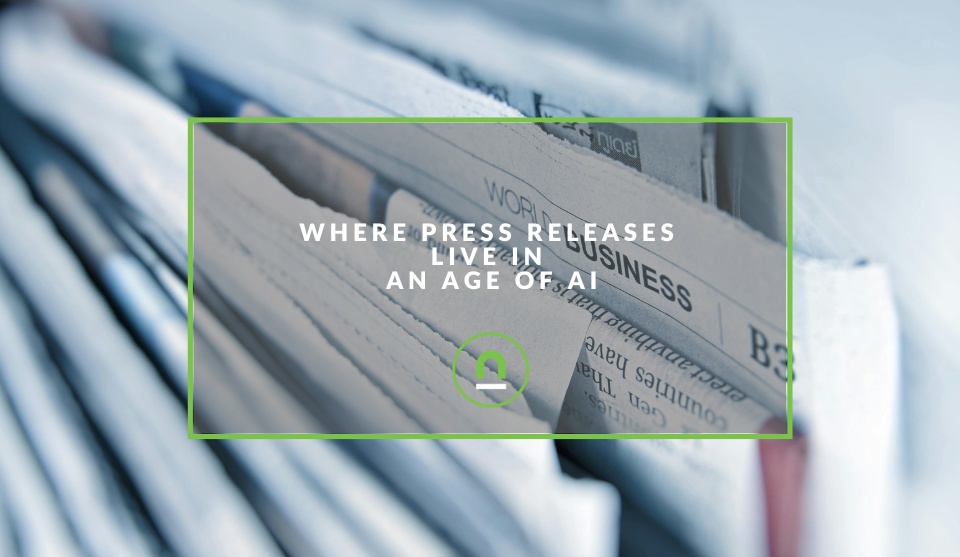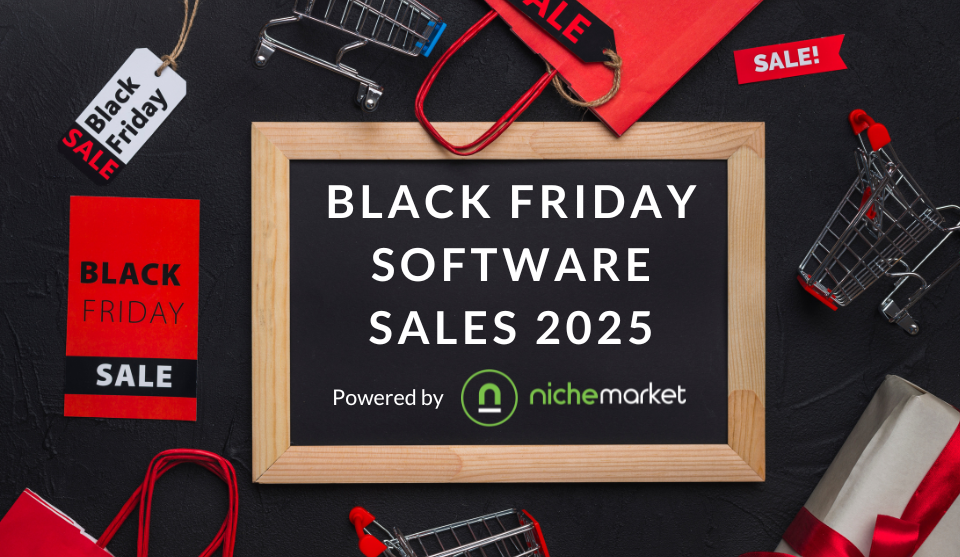Recent posts

nichemarket Advice
Where Press Releases Live In An Age of AI
21 November 2025

Shopaholics
48 Black Friday Software Deals 2025
14 November 2025

Money Talks
Maximising Business and Trading Opportunities Through Smart Online Strategies
07 November 2025

Shopaholics
How a Filter Jug Can Actually Improve Your Daily Water
30 October 2025
Popular posts
Extravaganza
Trending Music Hashtags To Get Your Posts Noticed
24 August 2018
Geek Chic
How To Fix iPhone/iPad Only Charging In Certain Positions
05 July 2020
Extravaganza
Trending Wedding Hashtags To Get Your Posts Noticed
18 September 2018
Money Talks
How To Find Coupons & Vouchers Online In South Africa
28 March 2019
Where Press Releases Live In An Age of AI
21 November 2025 | 0 comments | Posted by Che Kohler in nichemarket Advice
In an era dominated by social media, influencer marketing, and algorithm-driven content, the humble press release might seem like a relic of a bygone age. Yet the opposite is true.
Press releases have always been seen as a necessary evil, the ugly stepchild of the content world. You have to get those mentions out on publications, or how would you tap into new audiences? Especially audiences that remain stuck on 3rd-party platforms like social media or continue to use chatbots for instant access to information.
With so many eyeballs stuck in newsfeeds and chat logs, an organic mention or paid release would not be worth the time to push out anymore? Right?
Wrong!
Press releases have not only survived the digital transformation—they've become more valuable than ever. As large language models (LLMs) reshape how consumers discover, evaluate, and choose brands, press releases have emerged as a critical tool for ensuring your business remains visible, credible, and citeable across both traditional search engines and AI-powered platforms.
The Transformation of Press Releases in the AI Era
Press releases have always been about reaching journalists and getting media coverage. That core function remains intact. But a seismic shift has occurred in how information is discovered and consumed.
AI-powered platforms like ChatGPT, Perplexity, Google Gemini, and Claude are reshaping how users find information. Rather than clicking through lists of links, users increasingly turn to AI assistants for direct answers. According to research, ChatGPT alone reached over 200 million registered users by early 2025, and AI traffic to websites grew sevenfold compared to the previous year.
This creates a new imperative for businesses: your information needs to be structured, authoritative, and widely distributed enough that AI systems will cite it when users ask relevant questions. Press releases, with their factual structure, verified information, and distribution across authoritative domains, are uniquely positioned to meet this need.
Research into what drives AI-generated answers has revealed a crucial finding: earned media is the number one source of answers about brands on LLM-driven platforms.
When someone asks their preferred chatbot about companies in your industry, the AI draws heavily from published media coverage—and press releases are often the foundation of that coverage.
20 Benefits of Publishing Press Releases
1. Building Credibility and Trust
Press releases are considered official statements from organisations, carrying significant weight with media outlets, investors, and the public. When your company issues a press release, it signals that the information is verified and authoritative. This credibility is crucial for building trust with consumers, stakeholders, and increasingly, with AI systems that prioritise trustworthy sources.
Research indicates that positive or neutral media coverage increases credibility for companies, with more than half of PR professionals reporting that press releases have reinforced their brand authority and industry leadership position. In an age of misinformation and fake news, the official nature of press releases provides a foundation of trust that informal channels simply cannot match.
2. Enhancing Visibility in AI Search Results
Press releases have become essential for what's known as Generative Engine Optimisation (GEO) or Answer Engine Optimisation (AEO). Since AI models rely on clean, well-organised data to generate answers, a structured press release improves discoverability and citation by large language models.
Studies have shown that press release citations double in branded search contexts within AI platforms. When users search for your brand name on ChatGPT or Perplexity, the platform draws from the collective narrative about your company online—and press releases seed that narrative. Companies that regularly issue press releases are three times more likely to be quoted as industry experts in AI-generated responses.
3. Driving SEO Performance and Organic Traffic
Press releases remain powerful tools for search engine optimisation. When distributed through reputable channels, they create valuable backlinks to your website from high-authority domains. These backlinks enhance your site's authority and improve rankings in search results.
Beyond direct links, press releases support SEO through brand mentions, citation building, and accelerated indexing. Search engines regularly crawl media outlets because of their frequent content, so press release links often get indexed faster than other content. The resulting backlinks and increased authority continue to enhance SEO performance long after the initial publication.
4. Attracting Quality Media Coverage
Despite the evolution of digital marketing and social media, journalists still rely heavily on press releases for story ideas and source material. According to industry research, the vast majority of journalists consider official press releases their most trusted source for organisational news, and many rely on them for story ideas.
A well-crafted press release provides journalists with the accurate, verified information they need to write stories. Even when they don't cover your specific announcement, establishing credibility through professional press releases makes journalists more likely to work with you in the future.
5. Supporting Crisis Communication and Reputation Management
When crises occur, press releases serve as the formal channel to control the narrative and maintain stakeholder trust. Whether dealing with product recalls, data breaches, or public relations challenges, swift and transparent communication through press releases is crucial for damage control.
The official nature of press releases enables organisations to quickly release verified information, preventing speculation and misinformation from filling the void. They provide a consistent, documented record of your response that can be referenced across all communication channels—social media, email, direct outreach, and media briefings.
6. Creating a Foundation for Multi-Channel Content
Every press release serves as a content hub that can be repurposed across multiple marketing channels. A single announcement can be transformed into blog posts, email newsletters, social media content, video scripts, and infographics. This maximises resource efficiency while ensuring message consistency.
By integrating press releases into your broader content ecosystem, you create a cohesive narrative that reaches audiences wherever they consume information. The structured format of press releases makes them particularly easy to adapt for different platforms and audience segments.
7. Establishing Thought Leadership
Press releases offer a platform to share insights, achievements, and innovations that demonstrate your expertise and industry knowledge. When your releases include executive quotes, original research, or unique perspectives, they position your brand as a thought leader.
This thought leadership extends to AI visibility. LLMs weight content credibility heavily, preferring sources that demonstrate clear expertise and authoritative positioning. By consistently publishing insightful press releases, you build the kind of authority signals that AI systems use when deciding which sources to cite.
8. Providing Owned Media Control
Unlike social media posts that can be buried by algorithms or removed by platforms, press releases represent owned media over which you have complete control. You dictate the headline, the message, and the timing. This control is invaluable for ensuring your narrative remains accurate and consistent.
When press releases are published in your online newsroom, they create a permanent, authoritative reference point for your brand story. This centralised hub of verified information serves both human researchers and AI systems looking for reliable sources.
9. Supporting Investor Relations and Stakeholder Communication
For publicly traded companies or those preparing for IPOs, press releases are essential for maintaining transparency with shareholders and meeting regulatory requirements. Earnings releases, acquisition announcements, and strategic updates keep investors informed in a formal, compliant manner.
Press releases bridge the gap between detailed financial data and accessible communication. They allow companies to frame results in ways that resonate with financial audiences while providing the precision that institutional investors require. This dual function makes them indispensable for effective investor relations.
10. Generating Cost-Effective Brand Exposure
Compared to paid advertising, press releases offer exceptional return on investment. They require relatively minimal upfront costs but can generate substantial media coverage and brand exposure. Research indicates that most businesses experience improved visibility from published press releases.
The compound value of press releases—combining immediate media coverage with long-term SEO benefits, content repurposing opportunities, and AI visibility—makes them one of the most cost-effective marketing investments available. A single well-crafted release can continue generating value for months or years after publication.
11. Accelerating Product and Service Launches
Press releases remain one of the most effective tools for generating buzz around new products, services, or features. They create a moment of announcement that captures media attention and signals importance to the market.
For product launches, press releases provide the opportunity to explain not just what you're offering, but why it matters and who benefits. This context helps journalists write more compelling stories and helps AI systems understand where your product fits in the broader market landscape.
12. Building Quality Backlinks from Authoritative Sources
When press releases lead to coverage from journalists, bloggers, and industry publications, they generate organic backlinks from high-authority domains. These editorial backlinks carry more weight than typical link-building tactics because they represent genuine endorsements of newsworthiness.
The key is creating genuinely newsworthy content that journalists want to cover and cite. When your press release provides real news value, the resulting coverage builds a natural, diverse backlink profile that search engines recognize as authentic authority.
13. Enhancing Local SEO and Geographic Targeting
For businesses with local or regional focus, press releases support local SEO by reinforcing business name, address, and phone number across trusted directories and local news outlets. This consistency improves map rankings and local search performance.
AI search engines are increasingly sophisticated at providing location-specific results. Press releases distributed to regional publications help AI systems associate your brand with specific geographic areas, improving visibility for local searches across both traditional and AI-powered platforms.
14. Providing Documentation and Historical Record
Press releases create a documented timeline of your company's milestones, achievements, and evolution. This historical record serves multiple purposes: supporting due diligence in business transactions, providing context for journalists researching your company, and creating content that AI systems can reference when answering questions about your history.
This documentation function becomes increasingly important as AI systems develop longer memories and more sophisticated understanding of company timelines. A well-maintained archive of press releases provides the raw material for accurate AI-generated summaries of your company's journey.
15. Supporting Partnership and Collaboration Announcements
Press releases announcing partnerships, acquisitions, or collaborations serve as mutually beneficial marketing tools for all parties involved. They provide an official record of the relationship while generating exposure across multiple networks.
These announcements help AI systems understand the relationships between companies and individuals in your industry. When someone asks an AI about companies working in a particular space, these documented partnerships influence which names get mentioned together.
16. Enabling Rapid Information Dissemination
When timing matters—whether for regulatory announcements, time-sensitive promotions, or breaking news—press releases provide the fastest path to broad distribution. Wire services can distribute your news to thousands of outlets simultaneously, ensuring your message reaches relevant audiences quickly.
This speed is particularly valuable for publicly traded companies with disclosure obligations, but it benefits any organization that needs to communicate quickly with multiple stakeholders. The established infrastructure of press release distribution makes rapid, reliable communication possible.
17. Creating Signals for AI Training and Citations
As AI systems continue to evolve, the content they're trained on and the sources they reference become increasingly important for brand visibility. Press releases published across authoritative domains create multiple signals that AI systems recognize as trustworthy.
Content featuring original statistics and research findings sees significantly higher visibility in LLM responses because these systems are designed to provide evidence-based answers. Press releases that include specific metrics, concrete data, and verifiable claims are preferentially cited over general observations.
18. Protecting Against Misinformation
In an environment where misinformation spreads rapidly, press releases serve as authoritative corrections. When false information circulates about your company, a formal press release provides the verified counter-narrative that journalists and AI systems can reference.
The official status of press releases carries particular weight in AI contexts. When multiple sources conflict, AI systems tend to favor official company statements for factual claims about that company. This makes press releases your first line of defense against inaccurate AI-generated content about your brand.
19. Supporting Recruitment and Employer Branding
Press releases announcing awards, workplace achievements, expansion plans, or cultural initiatives support employer branding and recruitment efforts. They signal to potential employees that your company is newsworthy, growing, and worth joining.
These announcements also influence how AI systems describe your company as an employer. When prospective employees ask AI assistants about companies in your industry, the accumulated record of positive press releases shapes the response they receive.
20. Driving Measurable Business Results
Unlike many marketing activities, press release performance can be tracked and measured. Modern distribution services provide analytics on views, engagement, coverage, and referral traffic. This data enables continuous optimization of your press release strategy.
Beyond vanity metrics, press releases drive concrete business outcomes. They can generate buzz that increases sales, attract investor interest, support recruitment, and influence AI-generated recommendations that guide purchasing decisions. The measurable nature of these outcomes makes press releases accountable marketing investments.
How Press Releases Have Evolved in the LLM Landscape
The Shift from Links to Citations
Traditional press release SEO focused heavily on backlinks—getting other sites to link to yours. While backlinks remain valuable, the AI era introduces a new metric: citations. When an AI system answers a user's question by referencing your company or information from your press release, that's a citation. These citations happen whether or not there's a clickable link involved.
This shift has major implications for press release strategy. Content that gets cited by AI systems needs to be factual, specific, and structured in ways that LLMs can easily parse and attribute. Vague marketing language that might have been acceptable in traditional press releases becomes a liability when AI systems are looking for concrete, verifiable information.
The Importance of Structured Content
AI systems favour content with a consistent structure and clear formatting. Press releases that use clear headlines and subheadings, include verifiable data points, present information in logical hierarchies, and follow established conventions are more likely to be indexed, understood, and cited by LLMs.
This represents a return to fundamentals in some ways. The classic press release format—headline, dateline, lead paragraph answering who/what/when/where/why, supporting details, boilerplate—is well-suited to AI parsing because it follows predictable patterns that systems can reliably interpret.
The Value of Original Data and Research
Analysis of AI citation patterns reveals that content featuring original statistics and research findings receives substantially higher visibility in LLM responses. AI systems are designed to provide evidence-based answers, and they preferentially cite sources that offer specific, verifiable data.
This means press releases that include original research, survey findings, performance benchmarks, or proprietary metrics stand out from generic announcements. The data doesn't need to be groundbreaking—even modest original insights provide the kind of concrete information that AI systems value.
The Role of Third-Party Validation
AI systems don't just look at what you say about yourself—they examine what others say about you. Press releases generate earned media coverage, which generates third-party mentions, which AI systems use to understand what your company is and does.
This creates a multiplier effect. A press release that gets picked up by journalists creates multiple sources discussing your company, which strengthens the signals AI systems use when generating responses. The more varied and authoritative these third-party sources, the more confident AI systems become in citing your information.
The Convergence of SEO with LLM outputs
Search engine optimisation and generative engine optimisation are converging around similar principles: authority, accuracy, and accessibility. The same qualities that make content rank well in Google searches—trustworthiness, expertise, comprehensiveness—also make content likely to be cited by AI systems.
This convergence simplifies strategy in some ways. Press releases optimised for traditional search performance are generally well-positioned for AI visibility as well. But it also raises the stakes: content that fails these standards will be invisible in both contexts.
Best Practices for AI-Optimised Press Releases
Structure for Parseability
AI systems need to extract and attribute information from your press releases. Make this easy by using clear, descriptive headlines that summarize the key news, front-loading important information in the first paragraph, breaking complex information into digestible sections, using bullet points for lists and key data, and maintaining consistent formatting throughout.
Include Verifiable Facts
Vague claims don't get cited. Ensure your press releases include specific numbers and metrics wherever possible, named sources for quotes and data, dates and timeframes for announcements, and links to supporting documentation when relevant. AI systems are more likely to reference specific, verifiable information than general statements.
Optimize for Multiple Platforms
Different AI systems have different source preferences. Research indicates that Gemini favors brand-owned websites, ChatGPT rewards broad distribution across multiple sources, and Perplexity leans toward industry-specific directories and reviews. A comprehensive press release strategy should aim for visibility across all these contexts.
Maintain Consistency
AI systems examine how topics are discussed across multiple platforms. Inconsistent messaging—using different claims or facts in various places—confuses these models and undermines your brand's authority. Ensure your press releases align with information on your website, social profiles, and other public communications.
Create Evergreen Value
While press releases announce time-sensitive news, the best ones also provide lasting value through background information, industry context, or explanatory content that remains relevant over time. This evergreen material continues to serve as citable source material long after the news itself becomes dated.
Press Releases get a lease on a new life
Press releases have evolved from simple media announcements into sophisticated marketing tools that serve multiple strategic functions simultaneously. They build credibility with journalists, support SEO performance, enable crisis communication, facilitate investor relations, and increasingly, ensure visibility in AI-generated responses.
The rise of large language models hasn't diminished the importance of press releases—it has amplified it. As AI systems mediate more of how consumers discover and evaluate brands, the need for authoritative, structured, widely-distributed content has never been greater. Press releases, with their formal structure and distribution through trusted channels, are uniquely positioned to meet this need.
Organisations that master press release strategy in 2025 will find themselves visible across all the contexts that matter: traditional media coverage, search engine results, and AI-generated answers.
Those that neglect this tool risk becoming invisible precisely where decisions are increasingly made—in the responses that AI systems generate when users ask about products, services, and companies in your industry.
The fundamentals haven't changed: credibility, clarity, and newsworthiness remain essential.
Submit Your Press Release
We’ve launched a brand-new Press Release section on nichemarket, providing businesses with the opportunity to showcase their latest news, product launches, and announcements to our growing community of readers. Want your story featured? Contact us at info@nichemarket.co.za to submit your press release today.
You might also like
How to Choose the Best Forex Copy Trade Service in South Africa
21 October 2025
Posted by Mark Morris in Money Talks
An introduction to Forex copy trading and how South African traders can find platforms where they can hitch their wagon to seasoned forex traders tra...
Read moreGrow Your Practice With SEO - Physio's Guide To Marketing
28 October 2025
Posted by Nathan Meyer in Doctors Orders
Grow your physio practice with SEO, including advice on building locally relevant pages and optimisations to attract more real-world customers. Read ...
Read more{{comment.sUserName}}
{{comment.iDayLastEdit}} day ago
{{comment.iDayLastEdit}} days ago
 {{blogcategory.sCategoryName}}
{{blogcategory.sCategoryName}}

